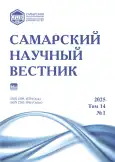Растительность озёрной полосы обмеления: эколого-биологические группировки (Южный Урал)
- Авторы: Исакова Н.А.1, Вейсберг Е.И.1
-
Учреждения:
- Южно-Уральский научный центр минералогии и геоэкологии УрО РАН
- Выпуск: Том 14, № 1 (2025)
- Страницы: 23-28
- Раздел: Биологические науки
- URL: https://bakhtiniada.ru/2309-4370/article/view/313652
- DOI: https://doi.org/10.55355/snv2025141103
- ID: 313652
Цитировать
Полный текст
Аннотация
В условиях климатических изменений при нарастающей антропогенной нагрузке происходит трансформация водных экосистем. Это отражается на структуре их биоценозов, в том числе на растительности прибрежных экотонов. Впервые при исследовании экологической структуры растительности песчано-каменистой полосы обмеления предгорного озера Большое Миассово (Южный Урал) применен эколого-биологический подход. Выделены эколого-биологические группировки – элементарные синузии, устанавленные на основе индекса доминирования, учитывающего показатели надземной фитомассы и встречаемости видов, и группы элементарных синузий (унионы), объединяющие элементарные синузии одной или близких биоморф. Экологические условия местообитаний оценены с помощью фитоиндикационных шкал Д.Н. Цыганова. Наиболее распространен в полосе обмеления унион травянистых монокарпиков, который формируют Persicaria lapathifolia (L.) S.F. Gray, Conyza canadensis (L.) Cronq., Potentilla norvegica L., P. supina L. Второй унион травянистых поликарпиков образован Stellaria bungeana Fenzl. Виды-доминанты относятся к эксплерентам, которые реализуют свои жизненные стратегии разными способами размножения. Эффективное семенное размножение и экологическая пластичность видов, формирующих унион травянистых монокарпиков, дают им преимущество в освоении местообитаний перед унионом травянистого поликарпика, размножающегося преимущественно вегетативно. Изучение эколого-биологической структуры позволяет оценить вклад отдельных видов в продуктивность прибрежных сообществ, а также прогнозировать их участие в формировании трофического статуса водоема.
Ключевые слова
Полный текст
Открыть статью на сайте журналаОб авторах
Наталья Александровна Исакова
Южно-Уральский научный центр минералогии и геоэкологии УрО РАН
Автор, ответственный за переписку.
Email: isakova_70@mail.ru
кандидат биологических наук, младший научный сотрудник биологического отдела; Ильменский государственный заповедник
Россия, г. Миасс, Челябинская областьЕлена Ивановна Вейсберг
Южно-Уральский научный центр минералогии и геоэкологии УрО РАН
Email: veisberg@mineralogy.ru
кандидат биологических наук, младший научный сотрудник биологического отдела; Ильменский государственный заповедник
Россия, г. Миасс, Челябинская областьСписок литературы
- Экология озера Большое Миассово / под ред. А.Г. Рогозина, В.А. Ткачева. Миасс: ИГЗ УрО РАН, 2000. 318 с.
- Casanova M.T., Brock M.A. How do depth, duration and frequency of flooding influence the establishment of wetland plant communities? // Plant Ecology. 2000. Vol. 147, № 2. P. 237–250.
- Coops H., Beklioglu M., Crisman T.L. The role of water-level fluctuations in shallow lake ecosystems – workshop conclusions // Hydrobiologia. 2003. Vol. 506–509, iss. 1–3. P. 23–27. doi: 10.1023/b:hydr.0000008595.14393.77.
- van der Valk A.G., Volin J.C., Wetzel P.R. Predicted changes in interannual water-level fluctuations due to climate change and its implications for the vegetation of the Florida Everglades // Environmental Management. 2015. Vol. 55, № 4. P. 799–806. doi: 10.1007/s00267-014-0434-4.
- Van Geest G.J., Wolters H., Roozen F.C.J.M., Coops H., Roijackers R., Buijse A.D., Scheffer M. Water-level fluctuations affect macrophyte richness in floodplain lakes // Hydrobiologia. 2005. Vol. 539, № 1. P. 239–248.
- Моисеенко Т.И., Гашкина Н.А., Хорошавин В.Ю. Прогноз влияния возможного потепления климата на химический состав вод суши // Доклады Академии наук. 2011. Т. 441, № 5. С. 666–669.
- Вейсберг Е.И. Разнообразие водной растительности системы озер Большое Миассово – Малое Миассово (Южный Урал) // Turczaninovia. 2014. Т. 17, № 4. С. 84–96.
- Вейсберг Е.И., Исакова Н.А. Реакция макрофитов на периодические изменения уровня воды (озеро Большое Миассово, Южный Урал) // Биология внутренних вод. 2022. № 2. С. 1–6. doi: 10.31857/s0320965222020176.
- Вейсберг Е.И. Видовой состав растительных группировок полосы обмеления в предгорном озере Большое Миассово (Южный Урал) // Биология внутренних вод. 2017. № 3. С. 35–45. doi: 10.7868/s0320965217030056.
- Баканов А.И. Количественная оценка доминирования в экологических сообществах // Количественные методы экологии и гидробиологии. Тольятти, 2005. С. 37–67.
- Серебряков И.Г. Экологическая морфология растений. М.: Советская наука, 1962. 378 с.
- Куликов П.В. Конспект флоры Челябинской области. Екатеринбург–Миасс: Геотур, 2005. 537 с.
- Корчагин А.А. Экологическое строение растительных сообществ. Учение о синузиях // Полевая геоботаника. Т. 5. Строение растительных сообществ. Л.: Наука, 1976. С. 132–198.
- Исакова Н.А. Видовое и синузиальное разнообразие листостебельных мхов восточного склона Ильменских гор. Миасс–Екатеринбург, 2009. 128 с.
- Berg Ch., Jörg E., Carsten H., Jürgen D. The whole and its parts: why and how to disentangle plant communities and synusiae in vegetation classification // Applied Vegetation Science. 2019. Vol. 23, № 1. P. 127–135. doi: 10.1111/avsc.12461.
- Gillet F., Julve P. The integrated synusial approach to vegetation classification and analysis // Phytocoenologia. 2018. Vol. 48, № 2. P. 141–152. doi: 10.1127/phyto/2017/0164.
- Guarino R., Guccione M., Gillet F. Plant communities, synusiae and the arithmetic of a sustainable classification // Vegetation Classification and Survey. 2022. № 3. P. 7–13. doi: 10.3897/vcs.60951.
- Липпмаа Т. О синузиях // Советская ботаника. 1946. Т. 14, № 3. С. 139–145.
- Трасс Х.Х. Ценоэлементы в растительных сообществах // Теоретические проблемы фитоценологии и биогеоценологии // Труды МОИП. 1970. Т. 38. С. 184–193.
- Цыганов Д.Н. Экологические шкалы растений [Электронный ресурс] // Ценофонд лесов Европейской России. http://cepl.rssi.ru/bio/flora.
- Горновский К.В. Водная растительность озер Большое Миассово и Большой Таткуль // Флора и лесная растительность Ильменского государственного заповедника им. В.И. Ленина: тр. Ильменского гос. заповедника. Вып. VIII. Свердловск, 1961. С. 57–84.
- Абрамова Л.М., Рогожникова Д.Р. К биологии инвазионного вида Conyza сanadensis (L.) Cronq. в Республике Башкортостан // Вестник Бурятского государственного университета. 2018. Вып. 3. С. 3–9. DOI: 18101/2587-7143-2018-3-3-9.
Дополнительные файлы









